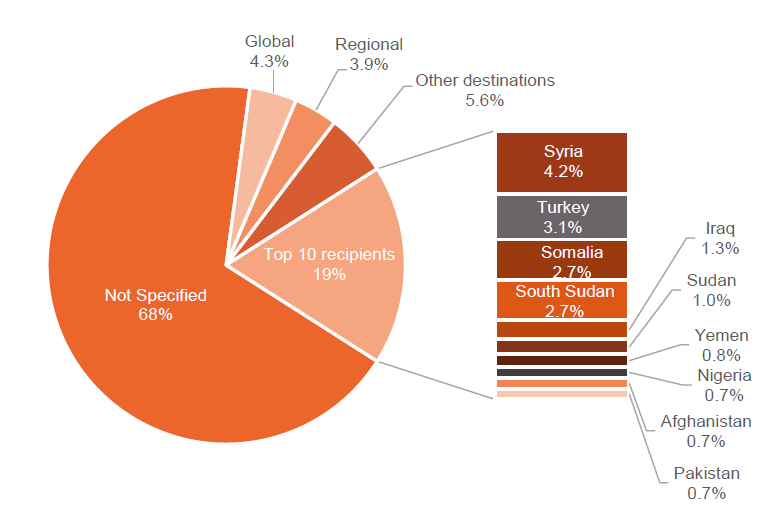Multi-year humanitarian funding: Global baselines and trends: Chapter 5
Country recipients of funding from donors
DownloadsFigure 4: Between 2016 and 2018, donors’ reported multi-year contributions were primarily directed to the largest recipient countries of international humanitarian assistance

68 percent of reported multi-year humanitarian contributions do not specify a destination country. Of the 32 percent of contributions where a destination was reported, 19 percent were directed to the top ten recipients of international humanitarian assistance. These are Syria, which received 4.2 percent, Turkey which received 3.1 percent, Somalia and South Sudan which each received 2.7 percent, Iraq which received 1.3 percent, Sudan which received 1 percent, Yemen which received 0.8 percent and Nigeria, Afghanistan and Pakistan which each received 0.7 percent.
Source: Development Initiatives, based on data provided bilaterally and from the International Aid Transparency Initiative (IATI). Data was collected between April and August 2019.
Notes: The dataset shown in the chart covers 11 institutional donors that are Grand Bargain signatories and reported to DI's survey. Multi-year funding also refers to funding agreements ranging between 12 and 24 months when defined as multi-year by the donor. UK Department for International Development data was collected from IATI and includes some technical operation costs. Data is in constant 2017 prices.
A large portion of donors reported that multi-year humanitarian contributions (68% from 2016 to 2018) do not specify a destination country. This large share may include a broader range of recipient countries, beyond the largest crises. Where data indicates a recipient destination, donors’ reported multi-year grants are concentrated on the largest crises, following a similar pattern to total humanitarian funding.
- Ten countries received 57% (US$2.1 billion) of the reported volume of multi-year funding with information on destination location. The largest contributions went to Syria (US$497 million), Turkey (US$360 million), Somalia (US$322 million), South Sudan (US$312 million) and Iraq (US$151 million).
- Over the 2016–2018 period, seven [1] of the reported 10 largest recipient countries of multi-year humanitarian contributions also featured among the 10 largest recipients of international humanitarian assistance in 2017. These latter 10 accounted for 51% of the total international humanitarian assistance in 2017.
- Close to 12% of reported multi-year humanitarian contributions with information on destination location were defined as regional (meaning they covered two or more specified countries or regions). This signals potential allocations to regional crises that can be described as softly earmarked multi-year grants. This is in addition to 13% of multi-year humanitarian funding with a destination location provided that was directed globally, usually in the form of unearmarked funds.
Where multi-year funding has increased, it has primarily been directed to high-visibility crises. It is broadly agreed that multi-year funding is suited to responses to protracted crises. This may have led to higher volumes of multi-year funding primarily directed to the crises in Syria, Yemen and Afghanistan. Simultaneously, recent high-level pledging conferences may have contributed to increased volumes of multi-year funding to these crises. However, this persistent concentration of funding in the largest crises [2] means that fewer resources are available for “forgotten” or less visible crises, which may be equally appropriate environments for multi-year funding.
Downloads
Notes
-
1
The seven countries are: Syria, Turkey, Somalia, South Sudan, Iraq, Yemen and Nigeria.Return to source text
-
2
Development Initiatives, Global Humanitarian Assistance report 2019. Available at: /publications/global-humanitarian-assistance-report-2019/Return to source text